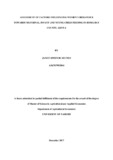| dc.description.abstract | . Inadequate dietary intake as a result of poor maternal, infant and young child feeding (MIYCF) practices is the foremost cause of vitamin A deficiency (VAD) in Kenya. Women and children‟s diets characteristically consist of starchy cereals necessitating nutrition interventions to improve consumption behaviour. Such interventions target intended beneficiaries using behavioural change methods aimed at transforming MIYCF practices. Accordingly, based on a goal-augmented model, this study investigated factors influencing women‟s behaviour towards MIYCF and the factors determining their use. Specific objectives addressed were (i) To analyse the effect of goals towards exclusive breastfeeding on behavioural intention; (ii) To analyse the effect of goals towards proper complementary feeding with foods that include OFSP on behavioural intention (iii) To analyse the effect of nutrition messaging on the intensity of using recommended infant and young child feeding practices; (iv) To examine the effect of income on mother‟s consumption of diverse diets. The study focused on women in Homa Bay County due to high incidence of VAD in the county. This study used a cross-sectional research design. Data was collected by administering a well-structured questionnaire to 764 respondents stratified into four categories, namely: pregnant mothers, mothers of 0-5 month old children, mothers with 6-23 month old children and potential mothers (i.e., 16-49-year old women not belonging to the first 3 categories at the time of the study). The study involved a field experiment in which the women were randomly assigned into control and treatment groups. The control group (n=377) was given verbal information on baby foods incorporating OFSP only, whereas the treatment group (n=387) received the information and were shown pre-prepared food samples. Data was analyzed using Partial Least Squares Path Modelling (PLS-PM) and Poisson Regression techniques. Results of the PLS-PM technique show that goals construct was the most significant determinant of intention to practice exclusive breastfeeding and use x
of OFSP in proper complementary feeding. For pregnant mothers and mothers with young children (i.e., 6-23-month olds), the most important determinant of goal-setting towards incorporating OFSP in complementary feeding was perceived behaviour control. For potential mothers, on the other hand, subjective norms were the most important influencer of goals to include OFSP in baby foods. Further, multi-group tests showed important difference in knowledge in favour of the treatment group. The results of the estimated Poisson Regression models show that nutrition messaging, counseling, mother-to-mother club health talks and cooking demonstrations positively influenced the intensity of using recommended IYCF practices. They also show that mothers‟ consumption of diverse diets is positively influenced by membership to a mother-to-mother clubs and off-farm income. Based on these findings, the study concludes that goals, perceived behaviour control and subjective norms are important determinants of intention to use recommended IYCF practices. Further based on Poisson Regression model, results of different nutrition education approaches are essential in adoption of recommended IYCF practices while membership to a mother-to-mother club as well as off-farm income are significant for a woman to consume diverse foods. Improvement of these factors thus could aid improving use of recommended MIYCF practices as well as adoption of OFSP as part of proper young child feeding. The study therefore, recommends that nutrition education interventions should equip mothers with planning and self-efficacy strategies. One strategy could involve use of small planning cards which explain the steps which women take towards implementing their intention. Additionally, nutrition education activities should also seek to influence a woman‟s social environment. The findings with respect to subjective norms point the need for also targeting women‟s social and economic environment by involving spouses and mother-in-laws in the nutrition promotions efforts. Moreover, results of the Poisson regression suggest the need to utilize mixed nutrition education methods in influencing behavior change | en_US |



